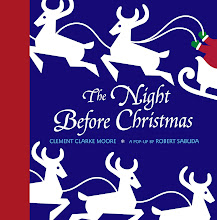
Paper Engineer Robert Sabuda is a pioneer in the field of Children’s Pop-Up Books. Since 1994, when he published his first title “The Christmas Alphabet,” Sabuda has not only been pushing the envelope and raising the bar in pop-up publishing, but he has virtually created his own genre. Though there are certainly other pop-up books being published, very few can compete with the sophisticated engineering of Sabuda’s work. Sabuda’s books, ranging from classic children’s novel adaptations to educational non-fiction titles to ABC books all feature beautifully drawn illustrations in vibrant colors combined with innovative pop-up engineering. The books range from six to eight double-page spreads, each more than an inch thick in order to support all of the behind-the-scenes engineering which make the pop-ups engage correctly. In the center of each spread, a large pop-up springs from the gutter shooting out toward the reader, sometimes as far as seven or eight inches high, as if it were coming to life. On either side of the main pop-up on the outer edges of each side of the spread are four-inch panels of text folded in an accordion style and clipped in place by a small corner holder. Readers unclip the panels and open up the text to read the story and find that the panels, too, have their own smaller pop-ups folded in. This method of putting the text in panels on the outside of the pages is an original Sabuda idea and is done only in his pop-up books. It is an innovation which allows him to build eye-popping center-spread pop-up feats while still maintaining room for the text. His books, which are three times as thick as any other pop-up book (about three inches wide) because of his elaborate pop-ups, are easily identified on bookstore shelves and have even become collector’s items, both for children and adults. Children delight in the eye-popping effects, while the adults marvel at the feats of engineering and the uniqueness of the art itself. On his site, Sabuda says "I think pop-ups appeal to adults because it allows them to revert back to their childhood experiences with things that amaze them. When an adult's eyes light up when turning the pages of a pop-up I know they've become big kids again!" (4). That is one of Sabuda's strengths as an artist -- the ability to create that child-like feeling of amazement in every reader of his works, no matter what the age. This excitement then impels the reader to go on with the reading of the text, thereby fostering that important synergistic relationship between the art and text.
But, Sabuda’s pop-up work is not just about creating eye-popping effects. It is also a way of enhancing the text of classic children’s novels. Just as author and artist William Blake uses his printing plate technique to combine the text of his poetry with his illustrations in order to create one cohesive artistic whole, Sabuda uses his pop-up engineering to create a synergistic relationship between art and text. He makes his illustrations into larger-than-life, interactive representations of the text, which bring the scenes to life, engage the reader more fully in the text, reinforce the themes of the text and allow the reader to see in real-time a three-dimensional representation of the story. In the article “Evocative Books: Books that Inspire Personal Response and Engagement,” published in the February 2005 issues of Reading Teacher, authors Catherine Kurkjian, Nancy Livingston, Kevin Henkes, Robert Sabuda and Lisa Yee talk about how pop-up books can “add, extend and develop the theme of the book and enhance aesthetic response in dramatic ways” (481). The excitement of seeing what is going to pop-up next makes the reader more engaged in the story: “The reader is propelled through the text to find out what will pop-up next” (481). At the same time, by seeing an important scene reenacted in three-dimensional space, the emotional impact and deeper themes become more apparent: “[Pop-ups] delight readers, demand attention, and cause the reader to think more deeply about how the pop-up relates to the text” (481). In Sabuda’s pop-up interpretation of Lewis Carroll's Alice’s Adventures in Wonderland, for example, Alice’s courageous decision to jump into the rabbit hole, which can be interpreted as her leap into the unconscious mind or into the chaos of adult life, is further enhanced by Sabuda’s accordion-style pop-up which literally allows the reader to look down into a tunnel, like a kaleidoscope, and see Alice tumbling into the darkness. In addition, the fear and confusion Alice experiences when she drinks the potion that makes her grow bigger (which could be representative of the confusing period between childhood and adulthood when such “growing pains” are experienced), is further enhanced by a three-dimensional representation of Alice’s large body stuck inside the small house: “We identify and gain insight into Alice’s physical discomfort at being too big when we peek into the window of the three-dimensional house and see her pained expression” (481).
Sabuda takes the concept of interpreting text in an artistic way one step beyond illustration, making it not just an artistic rendering of a scene from a text, but a larger-than-life, three-dimensional pop-up illustration of that scene. It’s almost like reading your favorite book and watching a movie of the book at the same time. The text and the visual are combined to enhance the experience and give a more well-rounded, cohesive whole.
Work Cited:
Kurkjian, Catherine; Livingston, Nancy; Henkes, Kevin; Sabuda, Robert and Yee, Lisa. "Evocative Books: Books That Inspire Personal Response and Engagement." Reading Teacher. February 2005. 480-488.
Photo credit:
http://authors.simonandschuster.net







